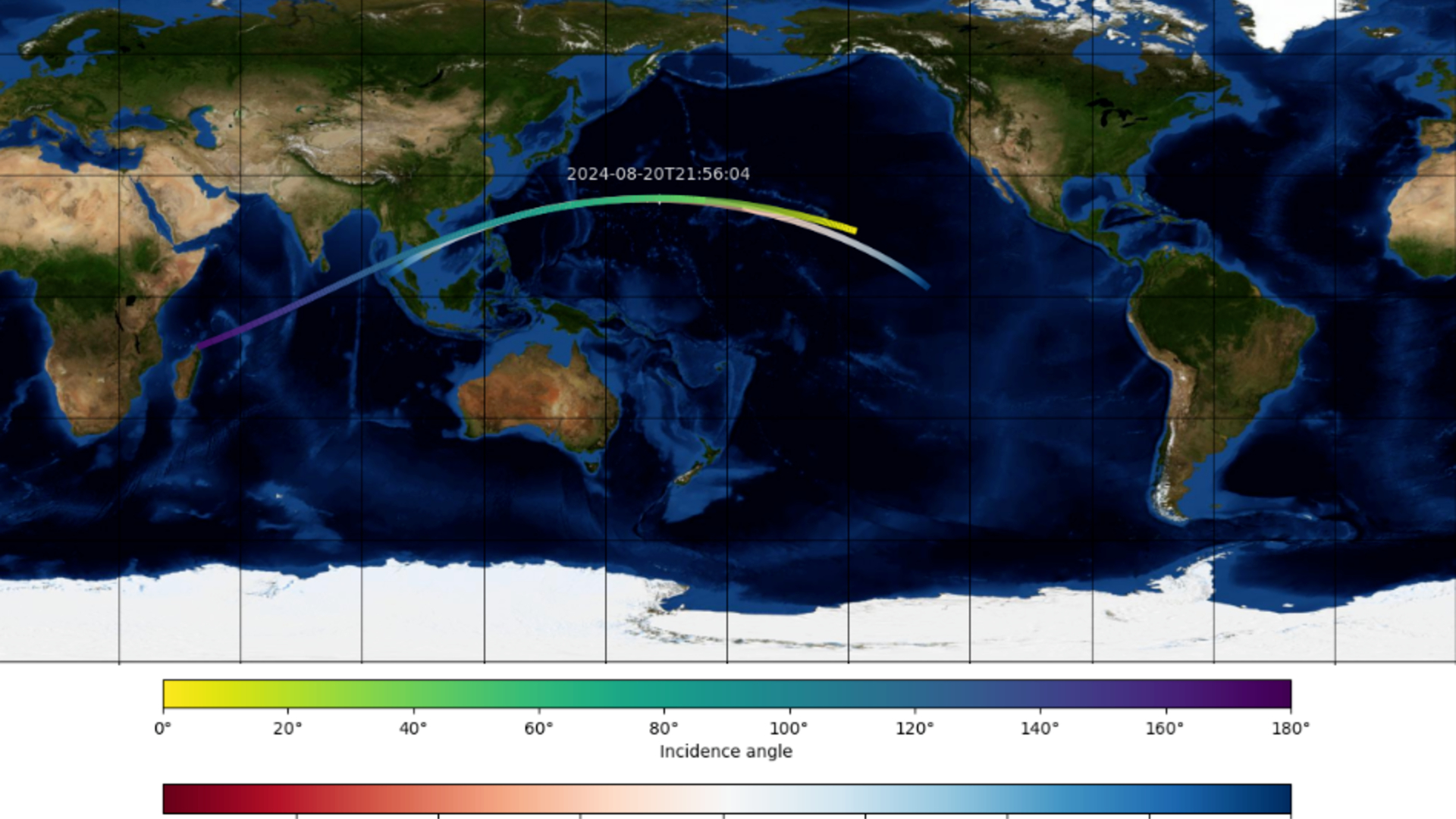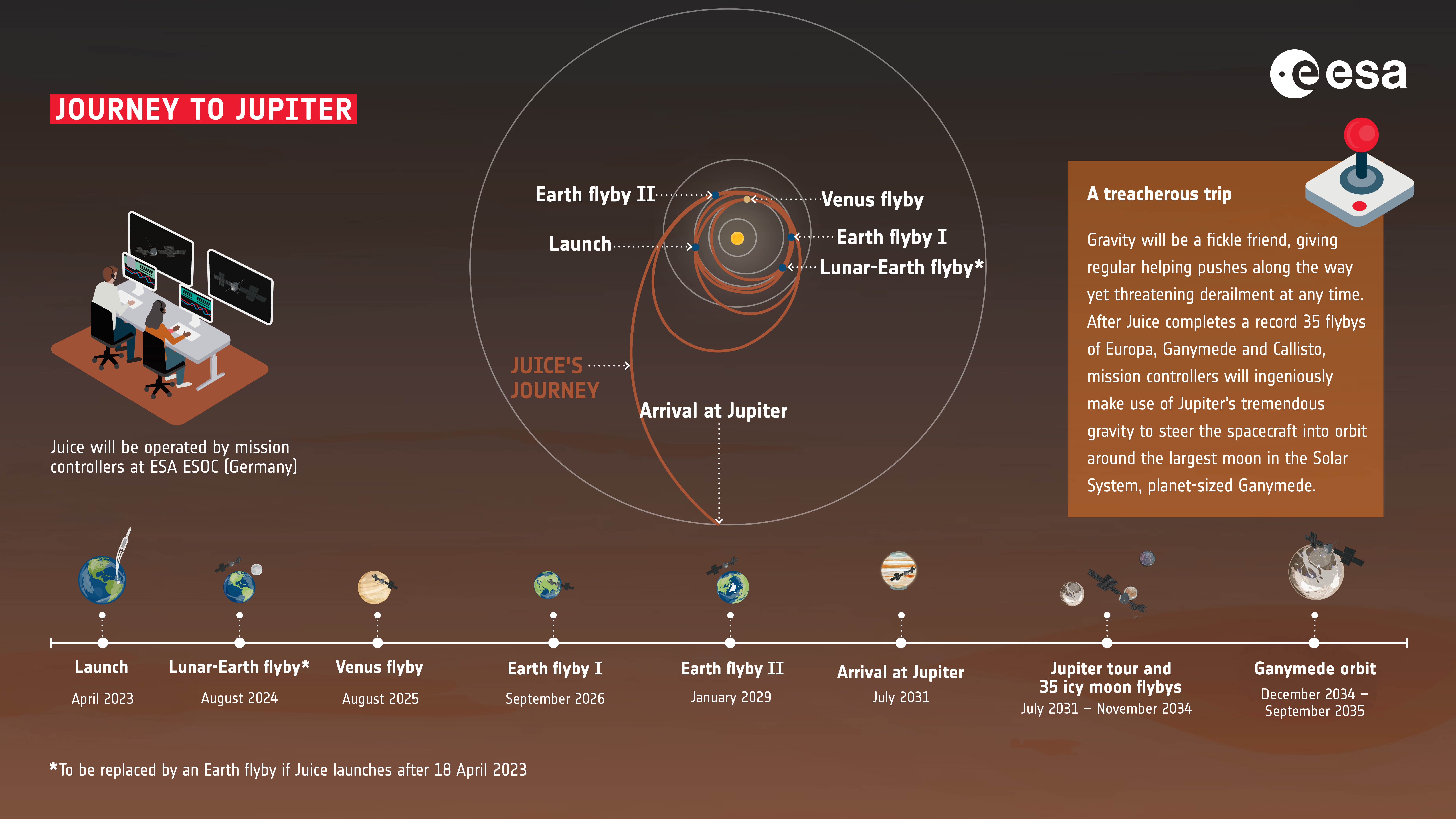
Europe's Jupiter Icy Moons Explorer probe, or JUICE for short, is scheduled to zip past Earth next month, and some skywatchers may be able to get a fleeting glimpse of the spacecraft.
The $1.1 billion JUICE, Europe's first-ever Jupiter mission, lifted off in April 2023 to study Jupiter and three of its biggest moons — Ganymede, Callisto and Europa, all of which are thought to harbor liquid-water oceans beneath their ice-covered surfaces.
On Aug. 19 and Aug. 20, Juice will glide past the moon and then Earth to get a gravitational boost. On Aug. 20, JUICE will make its closest approach to Earth at 5:57 p.m. Eastern time (2157 GMT), zipping just 4,200 miles (6,800 kilometers) or so above our planet's surface.

The close approach will come over Southeast Asia and the Pacific Ocean, and JUICE may be visible to some people in those regions. "Powerful binoculars or a telescope will give you the best chance of seeing the spacecraft," European Space Agency (ESA) officials said in a statement.
Related: JUICE: A complete guide to Jupiter's icy moon exploring mission
The maneuvers will change the spacecraft's speed and its course, setting JUICE up for one flyby of Venus next year and two of Earth by early 2029, which will get the probe on track to arrive in the Jupiter system in 2031 as planned. The trio of flybys is "the space exploration equivalent of drinking three back-to-back espressos," ESA officials said.
During the upcoming flyby, the mission team plans to turn on JUICE's 10 science instruments, including a key antenna called RIME ("Radar for Icy Moon Exploration") that struggled to unfurl in space after launch and deployed only after three weeks of intense troubleshooting efforts. The instrument continues to suffer from electronic noise from within the spacecraft, ESA said.
On Aug. 19, the engineers will get eight minutes of solo time with RIME to check how the noise is affecting the instrument's performance. The remaining instruments will either be switched off or reduced to a quiet mode, ESA officials said. Based on the brief observations, scientists may be able to come up with a new algorithm to correct the noise issue.

While the JUICE team is confident of successfully executing the upcoming flyby maneuvers, the effort is not without its risks, including the reliance on "real-time pinpoint accuracy" of the probe's position, the ESA statement noted.
"It's like passing through a very narrow corridor, very, very quickly: pushing the accelerator to the maximum when the margin at the side of the road is just millimeters," Ignacio Tanco, the mission's operations manager, said in the statement.
Ground stations around the world will be in constant contact with JUICE starting on Aug. 17, two days before its moon flyby. Operators will monitor data streaming from the spacecraft and make any adjustments necessary to keep it on the right path, ESA said.
A few gaps in communication are nevertheless impossible to avoid, like the half-hour break on Aug. 19 when JUICE slips behind the moon and a 20-minute stretch on Aug. 20 when the ground station loses visibility of the spacecraft, also shortly before its closest approach to our planet.
To travel to Jupiter without gravity assists, scientists estimate that JUICE would have needed a whopping 132,000 pounds (60,000 kilograms) of onboard propellant. Thanks to the anticipated help from these planetary flybys, the spacecraft launched with only 8,000 pounds (3,650 kgs).
From that precious reserve, 800 pounds (363 kgs), or 10% of the total, was used up in 43 minutes last November, when the mission team adjusted JUICE's path such that it will first glide past the moon, then a day later Earth, at the correct time, speed and direction next month. If all goes to plan, the remaining fuel will not be needed until JUICE arrives at Jupiter, Tanco previously said.
Throughout Aug. 20 flyby, Juice's two onboard cameras will capture photos of the moon and Earth, which will be released on social media as soon as the spacecraft beams them home, ESA said.







